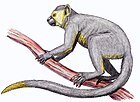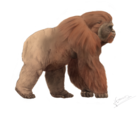
Homininae, is a subfamily of the family Hominidae (hominids). This subfamily includes two tribes, Hominini and Gorillini, both having extant species as well as extinct species.

Dryopithecus is a genus of extinct great apes from the middle–late Miocene boundary of Europe 12.5 to 11.1 million years ago (mya). Since its discovery in 1856, the genus has been subject to taxonomic turmoil, with numerous new species being described from single remains based on minute differences amongst each other, and the fragmentary nature of the holotype specimen makes differentiating remains difficult. There is currently only one uncontested species, the type species D. fontani, though there may be more. The genus is placed into the tribe Dryopithecini, which is either an offshoot of orangutans, African apes, or is its own separate branch.

Ouranopithecus is a genus of extinct Eurasian great ape represented by two species, Ouranopithecus macedoniensis, a late Miocene hominoid from Greece and Ouranopithecus turkae, also from the late Miocene of Turkey.

Mesopithecus is an extinct genus of Old World monkey belonging to the subfamily Colobinae that lived in Europe and Asia during the Late Miocene and Pliocene epochs, around 8.2-2.6 million years ago. Fossils span from Great Britain and the Iberian Peninsula in the west, eastwards to the Indian Subcontinent and China. Species of Mesopithecus had a body length of about 40 centimetres (16 in), possessing a slender body with long, muscular limbs and flexible fingers. Analysis of its anatomy suggests that members of the genus were semiterrestrial, spending a considerable amount of the time on the ground, though some authors have argued that some species were likely arboreal. Species of Mesopithecus were likely capable climbers and probably occasionally engaged in leaping. Dental microwear analysis suggests that it fed on hard seeds as well as probably leaves. The relationship of Mesopithecus to living members of Colobinae is uncertain, some have interpreted it as an early offshoot outside the split between Asian and African colobines, while others have interpreted it as a close relative of the Asian doucs (Pygathrix).

Indopithecus giganteus is an extinct species of large ape that lived in the late Miocene of the Siwalik Hills in northern India. Although frequently assigned to the more well-known genus Gigantopithecus, recent authors consider it to be a distinct genus in its own right.
Siamoadapis is an extinct genus of adapiform primate. Remains of its only known species, Siamoadapis maemohensis, were found in Thailand.
Stirtonia is an extinct genus of New World monkeys from the Middle Miocene. Its remains have been found at the Konzentrat-Lagerstätte of La Venta in the Honda Group of Colombia. Two species have been described, S. victoriae and the type species S. tatacoensis. Synonyms are Homunculus tatacoensis, described by Ruben Arthur Stirton in 1951 and Kondous laventicus by Setoguchi in 1985. The genus is classified in Alouattini as an ancestor to the modern howler monkeys.

Samburupithecus is an extinct primate that lived in Kenya during the middle to late Miocene. The one species in this genus, Samburupithecus kiptalami, is known only from a maxilla fragment dated to 9.5 million years ago discovered in 1982 and formally described by Ishida & Pickford 1997. The type specimen KNM-SH 8531 was discovered by the Joint Japan-Kenya Expedition at the SH22 fossil site in the Samburu District, a locality where several other researchers found no ape fossils.
Insulacebus is an extinct monotypic genus of New World monkey found on the island of Hispaniola from Late Quaternary deposits. Fossils of the type species Insulacebus toussaintiana have been recovered from the Plain of Formon, Department du Sud, southwestern Haiti. The body mass of the monkey was estimated between 4,159 and 5,443 grams. The dentally primitive I. toussaintiana was likely derived from a fauna that was evolving on the mainland before the Miocene monkey bed of the Honda Group of central Colombia, and stems from a pre-Middle Miocene colonization from the South American mainland.

Rangwapithecus is an extinct genus of ape from the Early Miocene of Kenya. Late Miocene phalanges from Hungary have also been assigned to this genus, but were later reclassified as Dryopithecus.
Indraloris is a fossil primate from the Miocene of India and Pakistan in the family Sivaladapidae. Two species are now recognized: I. himalayensis from Haritalyangar, India and I. kamlialensis from the Pothohar Plateau, Pakistan. Other material from the Potwar Plateau may represent an additional, unnamed species. Body mass estimates range from about 2 kg (4.4 lb) for the smaller I. kamlialensis to over 4 kg (8.8 lb) for the larger I. himalayensis.
Sivaladapis is a genus of adapiform primate that lived in Asia during the middle Miocene.

Cercopithecoides is an extinct genus of colobine monkey from Africa which lived during the latest Miocene to the Pleistocene period. There are several recognized species, with the smallest close in size to some of the larger extant colobines, and males of the largest species weighed over 50 kilograms (110 lb).

Cebupithecia is an extinct genus of New World monkeys from the Middle Miocene. Its remains have been found at the Konzentrat-Lagerstätte of La Venta in the Honda Group of Colombia. The type species is C. sarmientoi.
Micodon is an extinct genus of New World monkeys from the Middle Miocene. Its remains have been found at the Konzentrat-Lagerstätte of La Venta in the Honda Group of Colombia. The type species is M. kiotensis, a very small monkey among the New World species.
Saimiri fieldsi is an extinct species of New World monkey in the genus Saimiri from the Middle Miocene. Its remains have been found at the Konzentrat-Lagerstätte of La Venta in the Honda Group of Colombia.

Nyanzapithecus pickfordi is an extinct species of primate from the Middle Miocene of Maboko Island, Nyanza Province, Kenya. It had an average body mass of around 10 kg (22 lb).
Mioeuoticus is an extinct genus of lorisid primates from the Miocene of East Africa. It is the only genus in the subfamily Mioeuoticinae. Mioeuoticus was a relatively small, potto-sized animal with an omnivorous diet consisting of fruit and insects.
Yuanmoupithecus is an extinct genus of gibbons that lived 8.2 to 7.1 million years ago during the late Miocene. As of 2022, it is the oldest gibbon known. The fossils, mainly of teeth, were discovered from Yuanmou, Yunnan Province, China. The type species is Y. xiaoyuan, described by Yuerong Pan in 2006.













